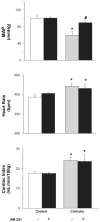Endocannabinoids acting at CB1 receptors mediate the cardiac contractile dysfunction in vivo in cirrhotic rats
- PMID: 17557913
- PMCID: PMC2225474
- DOI: 10.1152/ajpheart.00538.2007
Endocannabinoids acting at CB1 receptors mediate the cardiac contractile dysfunction in vivo in cirrhotic rats
Abstract
Advanced liver cirrhosis is associated with hyperdynamic circulation consisting of systemic hypotension, decreased peripheral resistance, and cardiac dysfunction, termed cirrhotic cardiomyopathy. Previous studies have revealed the role of endocannabinoids and vascular CB(1) receptors in the development of generalized hypotension and mesenteric vasodilation in animal models of liver cirrhosis, and CB(1) receptors have also been implicated in the decreased beta-adrenergic responsiveness of isolated heart tissue from cirrhotic rats. Here we document the cardiac contractile dysfunction in vivo in liver cirrhosis and explore the role of the endocannabinoid system in its development. Rats with CCl(4)-induced cirrhosis developed decreased cardiac contractility, as documented through the use of the Millar pressure-volume microcatheter system, low blood pressure, and tachycardia. Bolus intravenous injection of the CB(1) antagonist AM251 (3 mg/kg) acutely increased mean blood pressure, as well as both load-dependent and -independent indexes of systolic function, whereas no such changes were elicited by AM251 in control rats. Furthermore, tissue levels of the endocannabinoid anandamide increased 2.7-fold in the heart of cirrhotic compared with control rats, without any change in 2-arachidonoylglycerol levels, whereas, in the cirrhotic liver, both 2-arachidonoylglycerol (6-fold) and anandamide (3.5-fold) were markedly increased. CB(1)-receptor expression in the heart was unaffected by cirrhosis, as verified by Western blotting. Activation of cardiac CB(1) receptors by endogenous anandamide contributes to the reduced cardiac contractility in liver cirrhosis, and CB(1)-receptor antagonists may be used to improve contractile function in cirrhotic cardiomyopathy and, possibly, in other forms of heart failure.
Figures





References
-
- Bataller R, Arroyo V, Gines P. Management of ascites in cirrhosis. J Gastroenterol Hepatol. 1997;12:723–733. - PubMed
-
- Bátkai S, Járai Z, Wagner JA, Goparaju SK, Varga K, Liu J, Wang L, Mirshahi F, Khanolkar AD, Makriyannis A, Urbaschek R, Garcia N, Jr, Sanyal AJ, Kunos G. Endocannabinoids acting at vascular CB1 receptors mediate the vasodilated state in advanced liver cirrhosis. Nat Med. 2001;7:827–832. - PubMed
-
- Bonz A, Laser M, Kullmer S, Kniesch S, Babin-Ebell J, Popp V, Ertl G, Wagner JA. Cannabinoids acting on CB1 receptors decrease contractile performance in human atrial muscle. J Cardiovasc Pharmacol. 2003;41:657–664. - PubMed
Publication types
MeSH terms
Substances
Grants and funding
LinkOut - more resources
Full Text Sources
Other Literature Sources
Medical

